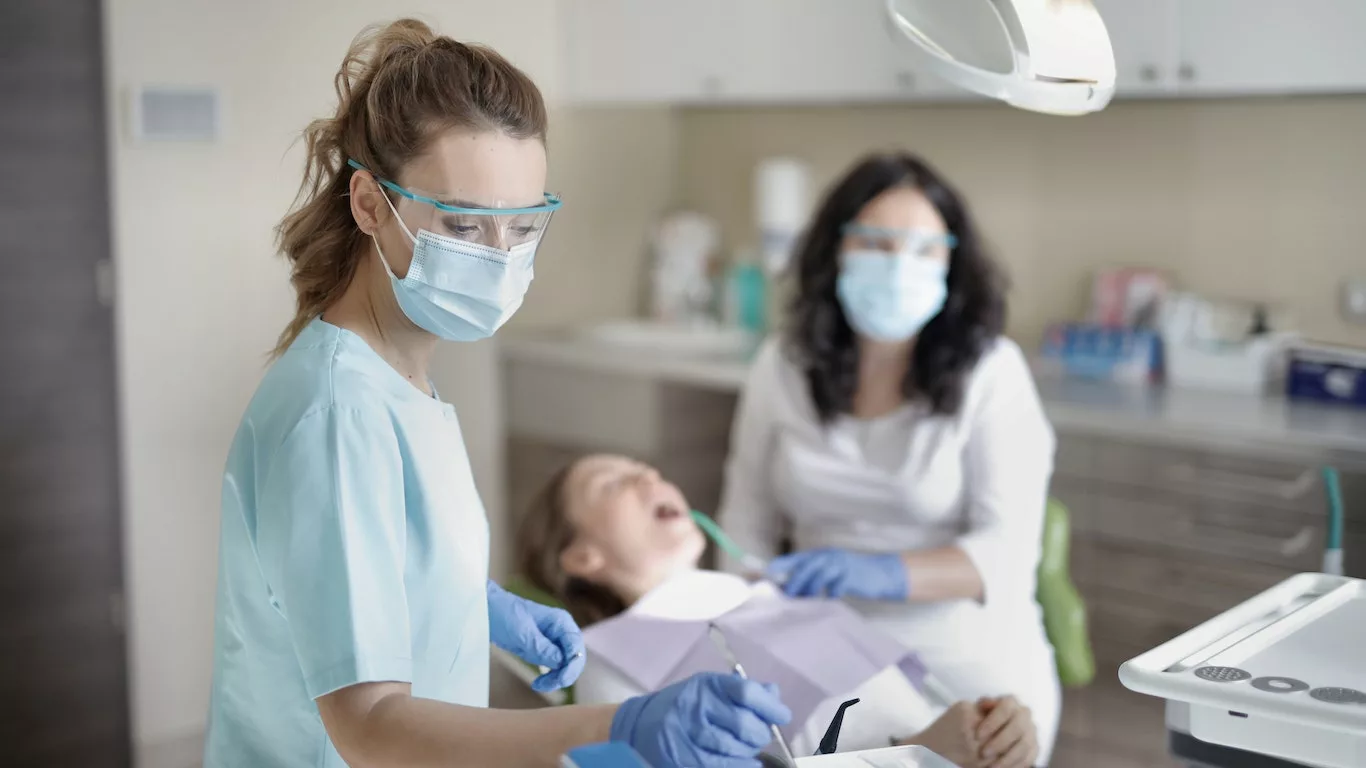Composite Resin Veneers: Your Ultimate Comprehensive Guide
Discover the transformative power of composite resin veneers in our comprehensive guide. Learn about the procedure, benefits, and maintenance for a radiant smile.
Are you longing for a radiant smile makeover? Composite resin veneers may be the transformative solution you’ve been searching for. In this in-depth guide, we’ll leave no stone unturned as we dive deep into the world of composite resin veneers. From understanding their composition and the intricacies of the procedure to exploring their remarkable advantages and potential limitations, we’ll provide you with a wealth of information. Whether you’re considering this cosmetic dentistry option or simply curious about it, read on to gain a comprehensive understanding of composite resin veneers.
Introduction
Composite resin veneers, often simply referred to as composite veneers, have become increasingly popular in the realm of cosmetic dentistry. These thin shells of tooth-colored material are meticulously crafted to bond to the front surface of your teeth, effectively concealing imperfections and creating a stunning smile. In this introduction, let’s take a closer look at the essence of composite resin veneers, including what they are, the advantages they offer, and the overarching purpose of this comprehensive guide.

Understanding Composite Resin Veneers
Composition and Material
The heart of composite resin veneers lies in their composition. These veneers are primarily made of a special dental resin, which is skillfully blended with other materials to achieve the ideal characteristics. The resin is chosen for its ability to mimic the appearance of natural teeth, both in color and translucency. This material is not only highly aesthetic but also durable.
How They Differ from Other Veneers
One of the key distinctions of composite resin veneers is their conservative nature. Unlike their porcelain counterparts, composite veneers require minimal tooth reduction during the preparation phase. This means that your natural tooth structure remains largely intact, making the procedure less invasive and preserving the overall health of your teeth. Additionally, the materials used in composite veneers allow for easy repairs if they are ever damaged, making maintenance more straightforward.
Indications for Composite Resin Veneers
Composite resin veneers are incredibly versatile. They can address a wide range of dental concerns, making them suitable for various situations. Whether you’re dealing with discolored teeth, minor chips or cracks, gaps, or irregularly shaped teeth, composite veneers can provide a solution. Understanding when and how these veneers can be used is essential for determining if they align with your specific dental needs.

The Procedure
Initial Consultation
Your journey to a new smile with composite resin veneers begins with an initial consultation with your dentist. This is your opportunity to discuss your smile goals, express your concerns, and establish realistic expectations. Your dentist will evaluate your oral health, take impressions of your teeth, and work with you to develop a treatment plan tailored to your unique needs.
Tooth Preparation
The tooth preparation phase is where your dentist will remove a thin layer of enamel from the front surface of the teeth receiving the veneers. This step is essential to create space for the veneers and ensure a natural-looking result. The amount of enamel removed is minimal compared to other veneer options, making composite veneers a conservative choice.
Composite Resin Application
With the teeth prepared, the composite resin is skillfully applied in layers to achieve the desired shape and appearance. Your dentist will carefully select the shade of resin that matches your natural teeth, ensuring a seamless blend. Each layer is meticulously bonded and sculpted to achieve the desired shape and contour.
Bonding and Shaping
The bonding process is a critical step in ensuring the veneers adhere securely to your teeth. Your dentist will use a special adhesive and curing light to bond the veneers in place. Once bonded, any necessary shaping and adjustments are made to ensure a comfortable fit and a harmonious appearance with your surrounding teeth.
Final Polishing
To complete the procedure, your dentist will meticulously polish the composite resin veneers. This final step enhances the aesthetics of your veneers and ensures a smooth, natural feel. The end result is a stunning smile that looks and feels like your own.
Composite resin veneers offer a relatively quick and minimally invasive way to enhance your smile, often requiring just one or two dental visits to achieve remarkable results.

Advantages of Composite Resin Veneers
Aesthetic Benefits
The ability of composite resin veneers to mimic the natural appearance of teeth is unmatched. The material can be precisely matched to your existing teeth, creating a seamless and harmonious smile. The composite material also possesses a natural translucency, allowing light to pass through and reflect off the teeth, just like real enamel.
Minimal Tooth Reduction
One of the most significant advantages of composite veneers is their conservative approach to tooth preparation. Compared to porcelain veneers, which often require more substantial enamel removal, composite veneers preserve much of your natural tooth structure. This minimally invasive approach is less damaging to your teeth and can often be accomplished with little to no discomfort.
Cost-Effectiveness
For those seeking an affordable yet effective smile enhancement option, composite resin veneers are a compelling choice. They tend to be more budget-friendly than porcelain veneers while still delivering outstanding aesthetic results. This makes them accessible to a wider range of individuals looking to improve their smiles.
Durability and Longevity
Composite resin veneers are designed to withstand the daily wear and tear of everyday life. With proper care and maintenance, they can last for many years. Their durability makes them an excellent investment in your long-term oral health and confidence.

Disadvantages and Limitations
Staining and Discoloration
While composite veneers are highly resistant to staining, they are not completely immune. Over time, exposure to staining agents like coffee, tea, red wine, and tobacco can cause some discoloration. Regular dental check-ups and professional cleanings can help prevent and address this issue.
Repair and Maintenance
Composite resin veneers, although durable, can chip or wear down over time. The good news is that repairs can often be made without the need to replace the entire veneer. Your dentist can address minor damages by adding additional layers of composite material and re-polishing the veneer to restore its original appearance.
Longevity Compared to Porcelain Veneers
While composite resin veneers offer excellent longevity, they may not match the lifespan of porcelain veneers. Porcelain veneers are known for their exceptional durability and resistance to staining. However, composite veneers offer a more conservative approach and are easier to repair, making them a preferred choice for some patients.

Caring for Composite Resin Veneers
Proper care and maintenance are essential to ensure the longevity and continued beauty of your composite resin veneers. This section explores best practices for maintaining your new smile:
Oral Hygiene Tips
Maintaining excellent oral hygiene is crucial to prevent dental issues and keep your veneers looking their best. Brushing and flossing regularly is a must. Be sure to use a non-abrasive toothpaste to avoid scratching the surface of the veneers. Your dentist can recommend suitable oral care products to help you maintain your veneers.
Diet and Lifestyle Considerations
Certain foods and lifestyle habits can impact the appearance of your veneers. Limiting your consumption of staining agents like coffee, tea, red wine, and tobacco can help prevent discoloration. If you do indulge in these substances, consider rinsing your mouth or brushing your teeth shortly afterward. Additionally, avoid biting into hard objects, like ice or pens, as this can potentially damage your veneers.
Regular Check-Ups
Consistent dental check-ups are vital to monitor the health of your veneers and ensure they remain in optimal condition. Your dentist will perform thorough examinations and professional cleanings to keep your teeth and veneers in top shape. These appointments also provide an opportunity to address any concerns or questions you may have.

Comparing Composite Resin Veneers to Other Options
To make an informed decision about veneers, it’s crucial to compare composite resin veneers to other available options. Let’s explore these comparisons in greater detail:
Porcelain Veneers vs. Composite Resin Veneers
Porcelain veneers and composite resin veneers are both effective smile enhancement options, but they have distinct differences. Porcelain veneers are known for their exceptional durability and resistance to staining. They are a suitable choice for individuals looking for a long-term solution. However, they require more extensive tooth reduction during the preparation process and are more challenging to repair if damaged. In contrast, composite resin veneers offer a conservative approach, preserving more of your natural tooth structure, and are easier to repair if necessary.
Composite Resin Veneers vs. Bonding
Dental bonding is a procedure that uses a tooth-colored resin to repair minor imperfections in teeth. While similar in material, composite resin veneers and bonding differ in their application and purpose. Composite veneers are thin shells custom-made to enhance the aesthetics of your smile, while bonding is typically used for smaller repairs, like filling in a chip or gap. Bonding may be a more budget-friendly option for minor issues, but composite veneers provide a more comprehensive and long-lasting solution for smile makeovers.

Choosing a Qualified Dentist
Selecting the right dentist is a critical step in your journey to obtaining composite resin veneers. To ensure a successful and satisfying experience, consider the following factors when choosing a dentist:
Experience and Expertise: Look for a dentist with experience in cosmetic dentistry and a track record of successful veneer placements. An experienced dentist is more likely to achieve the desired aesthetic results.
Patient Reviews and Testimonials: Reading reviews and testimonials from previous patients can provide valuable insights into the quality of care provided by a dentist. Positive feedback and before-and-after photos can help you gauge their expertise.
Consultation Checklist
Preparing for your initial consultation with a dentist is essential for effective communication and achieving your desired results. Use this checklist to ensure a productive consultation:
- Clearly Define Your Goals: Before your appointment, make a list of what you hope to achieve with composite resin veneers. Do you want to whiten your teeth, close gaps, or address chips or cracks? The more specific you are about your goals, the better your dentist can tailor the treatment plan to your needs.
- Ask Questions: Don’t hesitate to ask questions during your consultation. Inquire about the dentist’s experience with composite veneers, the expected timeline for the procedure, and any potential risks or complications.
- Discuss Your Budget: Be upfront about your budget and any financial constraints you may have. Your dentist can work with you to explore options that align with your financial situation.
- Review Before-and-After Photos: Ask to see before-and-after photos of previous patients who have undergone composite resin veneer procedures. This visual evidence can help you set realistic expectations and gain confidence in your dentist’s abilities.

Cost and Insurance
Understanding the financial aspects of composite resin veneers is an important consideration. Let’s delve into this topic further:
Cost Factors
The overall cost of composite resin veneers can vary depending on several factors:
- The number of veneers required: If you’re enhancing only a few teeth, the cost will be lower than a full smile makeover.
- The complexity of the case: Addressing more significant dental issues may require additional time and materials, affecting the cost.
- Geographic location: Prices for dental procedures can vary by region and even within the same city or town.
- The experience of the dentist: Experienced cosmetic dentists may charge higher fees for their expertise.
Insurance Coverage
Dental insurance plans typically do not cover cosmetic procedures like composite resin veneers. However, if the veneers are necessary for restorative purposes, such as repairing a damaged tooth, some insurance plans may provide partial coverage. It’s essential to check with your insurance provider to understand your specific coverage and any potential reimbursement.

Case Studies and Before-and-After
Seeing real-life examples of composite resin veneer transformations can provide invaluable insight into the potential results of this procedure. Here, we present case studies and before-and-after photos to showcase the remarkable impact of composite veneers on individuals’ smiles:
Case Study 1: Teeth Discoloration
Patient A came to our clinic with concerns about severe teeth discoloration. Years of coffee consumption had left their teeth noticeably stained and discolored, impacting their self-confidence. After a thorough evaluation, our dentist recommended composite resin veneers as an effective solution.
The procedure involved the placement of veneers on the upper front teeth, carefully matching the veneers’ shade to the patient’s surrounding teeth. The result was a dramatic transformation, with the patient’s teeth now exhibiting a natural and radiant appearance. Patient A reported a significant boost in self-esteem and a newfound willingness to smile freely.
Case Study 2: Minor Tooth Gaps
Patient B had always been self-conscious about the gaps between their front teeth. While the gaps were minor, they were a constant source of discomfort and insecurity. Composite resin veneers offered an ideal solution for closing these gaps and enhancing the overall appearance of the smile.
The treatment plan involved placing veneers on the two front teeth, sculpting them to create a harmonious alignment with the surrounding teeth. The result was a stunning, gap-free smile that transformed the patient’s self-confidence. Patient B expressed immense satisfaction with the procedure, citing the immediate positive impact on their life.
Case Study 3: Chipped Tooth Repair
Patient C had suffered a minor accident resulting in a chipped front tooth. The injury had left them feeling self-conscious and concerned about further damage. Composite resin veneers presented an effective solution for repairing the chipped tooth and restoring its natural appearance.
The procedure involved bonding a custom-made veneer to the chipped tooth’s surface, carefully shaping and polishing it to blend seamlessly with the adjacent teeth. The result was a flawless smile with no visible evidence of the previous damage. Patient C reported a newfound sense of confidence and relief after the procedure.

Conclusion
In conclusion, composite resin veneers offer an exceptional solution for enhancing your smile. Their ability to replicate the natural appearance of teeth, minimal tooth reduction, cost-effectiveness, and durability make them a compelling choice for many individuals. While they are not without limitations, proper care and maintenance can help maximize their longevity and maintain their aesthetic appeal.
By understanding the intricacies of composite resin veneers, you can make an informed decision about whether they align with your cosmetic dentistry goals. Remember that choosing a qualified dentist with experience in cosmetic dentistry is paramount to achieving the best results.
We hope this comprehensive guide has provided you with a thorough understanding of composite resin veneers, from their composition and procedure to their advantages, limitations, and maintenance. Armed with this knowledge, you can confidently embark on your journey to a brighter, more confident smile
Appendices
References
- Peumans, M., Van Meerbeek, B., Lambrechts, P., & Vanherle, G. (1996). Porcelain veneers: a review of the literature. Journal of Dentistry, 24(1), 3-12. Link
- Gresnigt, M. M. M., Özcan, M., & van den Houten, M. L. A. M. (2011). The clinical performance of veneered zirconium dioxide-based single crowns: A systematic review. The Journal of Prosthetic Dentistry, 105(6), 387-395. Link
- Baroudi, K., & Rodrigues, J. C. (2013). Flowable resin composites: a systematic review and clinical considerations. Journal of Clinical and Experimental Dentistry, 5(3), e124-e130. Link
FAQs
As with any dental procedure, you likely have questions. In this section, we’ll address some of the most common questions about composite resin veneers, providing you with clear and concise answers to help alleviate any concerns or uncertainties you may have.
Q1. How long do composite resin veneers typically last?
A1. With proper care and maintenance, composite resin veneers can last anywhere from 5 to 10 years or even longer. Regular dental check-ups and avoiding habits like teeth grinding and biting into hard objects can help extend their lifespan.
Q2. Are composite resin veneers stain-resistant?
A2. Composite resin veneers are highly resistant to staining; however, they are not entirely immune. It’s advisable to limit the consumption of staining agents like coffee, tea, and red wine and practice good oral hygiene to prevent discoloration.
Q3. Can composite resin veneers be repaired if damaged?
A3. Yes, one of the advantages of composite resin veneers is their repairability. Minor damages, such as chips or cracks, can often be repaired without the need to replace the entire veneer. Your dentist can add additional layers of composite material and re-polish the veneer to restore its appearance.
Q4. How do composite resin veneers compare to porcelain veneers in terms of cost?
A4. Composite resin veneers are generally more budget-friendly than porcelain veneers. While the exact cost can vary depending on factors like the number of veneers needed and your location, composite veneers are often a more cost-effective option for smile enhancement.
Q5. Can I whiten my teeth if I have composite resin veneers?
A5. Composite resin veneers do not respond to teeth whitening treatments. If you’re considering teeth whitening, it’s best to do so before getting veneers to ensure a consistent shade across all your teeth.
Table: Comparison of Composite Resin Veneers and Porcelain Veneers
| Aspect | Composite Resin Veneers | Porcelain Veneers |
|---|---|---|
| Durability | 5-10 years or longer | 10-15 years or more |
| Tooth Reduction | Minimal | Moderate |
| Repairability | Yes | Limited |
| Cost | Budget-friendly | Higher investment |
| Stain Resistance | Highly resistant | Highly resistant |
| Aesthetic Appearance | Natural, translucent | Natural, translucent |
| Procedure Duration | One to two visits | Two or more visits |
Disclaimer
The information provided in this article is for educational and informational purposes only. It is not intended as a substitute for professional dental advice, diagnosis, or treatment. Always seek the advice of your dentist or other qualified healthcare providers regarding any dental concerns. The authors and publisher of this article are not responsible for any actions taken based on the information provided herein.

Camellia Wulansari is a dedicated Medical Assistant at a local clinic and a passionate health writer at Healthusias.com. With years of hands-on experience in patient care and a deep interest in preventive medicine, she bridges the gap between clinical knowledge and accessible health information. Camellia specializes in writing about digestive health, chronic conditions like GERD and hypertension, respiratory issues, and autoimmune diseases, aiming to empower readers with practical, easy-to-understand insights. When she’s not assisting patients or writing, you’ll find her enjoying quiet mornings with coffee and a medical journal in hand—or jamming to her favorite metal band, Lamb of God.







